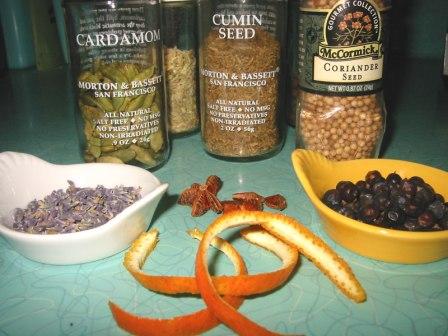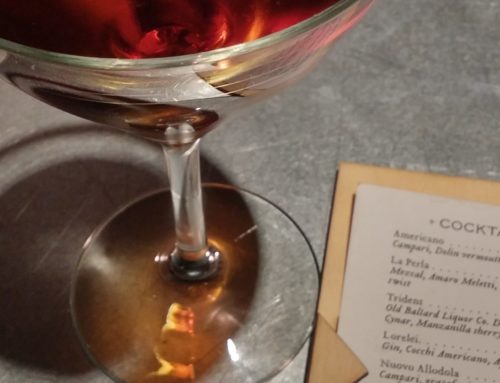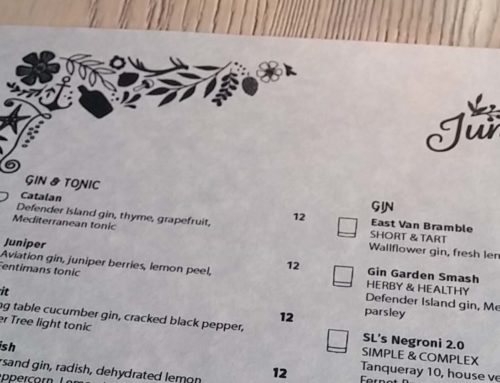And no, to answer your first question: a bathtub was not involved.
Having written and spoken as much as I have about gin over the years, it seems somewhat sacrilegious to suggest that I “made” gin. I’ve been to too many distilleries, sampled too many quality gins, and studied too much the art and science of gin-making to believe what I have in this bottle is truly gin.
But, an oft-repeated characteristic of gin is that–at its core–it is essentially  infused vodka. By definition, gin begins with a neutral spirit (which vodka is) into which botanicals are infused. Juniper is the only “must” on that list of flavorings, other elements include citrus, flowers, herbs, seeds, spices, roots. And techniques for melding the aromatics with the spirit vary. It’s why I think of gin as the most culinary of all spirits, the distiller has lots of room to follow creative impulses and come up with a distinctive product with a signature blend of botanicals.
infused vodka. By definition, gin begins with a neutral spirit (which vodka is) into which botanicals are infused. Juniper is the only “must” on that list of flavorings, other elements include citrus, flowers, herbs, seeds, spices, roots. And techniques for melding the aromatics with the spirit vary. It’s why I think of gin as the most culinary of all spirits, the distiller has lots of room to follow creative impulses and come up with a distinctive product with a signature blend of botanicals.
What spurred this recent exercise was a posting at Gourmet magazine’s site by food editor Ian Knauer (since relegated to the ethers, but this blog post seems to have captured the original recipe Ian provided). At first I scoffed, quick to discount such a simplified version of gin’s process. But there I was at the liquor store buying a bottle of Smirnoff vodka. Everything else I had on hand at home. I didn’t follow Knauer’s recipe to the letter. I used orange peel in place of lemon or lime, a generous teaspoon of dried lavender blossoms in place of fresh and omitted fresh rosemary, adding star anise instead. I also just threw everything in at once, rather than pre-infusing with juniper.
Oh, that jar of cumin you see in the photo? Mentally omit that. I thought better of adding any to this concoction, afraid it would have an overpowering effect on the balance of things. Maybe if I take up homemade aquavit one of these days; cumin seems more suited to that spice-imbued spirit.
It was interesting to see how much color the vodka took on overnight. After a good 24 hours or so of infusing, I strained the “gin” and poured it back into the bottle. I also picked out most of the juniper berries from the strainer and popped them back in the bottle as well, wishing I’d used more in the first place. All in all, it’s a pretty darn well balanced, flavorful, aromatic spirit to sip. I was surprisingly pleased with the results. It will be a fun idea to play around with more over the months. Interestingly, this bottle came to the rescue when we got snowed in last week. I’d polished off the last of the No. 209 gin I had on the shelf and failed to restock before the snowflakes started falling. So my homemade version tided me over until we made the chilly 2½ mile trek as far as our nearest liquor store a few days later.
So, about that bathtub gin of yore. I do have a recipe that Seattle barman Michael Vezzoni, at the elegant Fairmont Olympic Hotel downtown, shared, which he’d come up with after a good deal of research. A few years back, the hotel celebrated its 80th anniversary, the festivities for which included an “Eight Decades of Cocktails” list created by Vezzoni, with the Harvey Wallbanger in honor of the 1960s, the Singapore Sling for the 1920s and the ubiquitous Cosmopolitan for this decade. Count back 80 years and you find yourself in the early years of prohibition. In honor of the hotel’s day-of anniversary celebration in 2004, Vezzoni went so far as to put together a big batch of bathtub gin”with over a dozen botanicals (including juniper, coriander, orange zest, cassia bark and caraway)”for the night’s martinis. It was a unique taste of history, adding perspective to the distinct story of gin.



Interesting and informative post! Thanks for the suggestions of flavors to try besides juniper.
Here in Argentina, one can make one’s own gin starting with 96% pharmaceutical grade ethanol, available in 500 ml bottles for the equivalent of about a dollar. I add 15 berries collected from a reasonable facsimile of some juniper bushes in our yard, and dilute with well water up to a liter total volume. Continuing the cheap route, tonic water is available in 1.2 liter bottles for 1.69 Argentine pesos, something under 50 US cents.
[…] bandwagon as so many have (including David Lebovitz). I’ve already played around with custom gin-like infusions and was due to experiment a bit more with that. Imagine all the delicious potential of a G & T […]